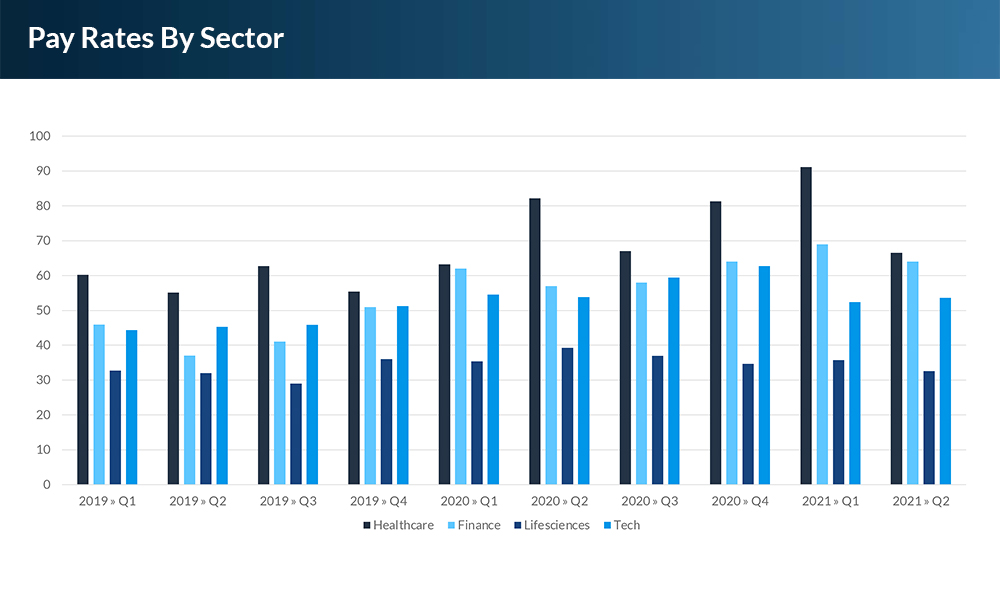Searching for a “New Normal” in PRO Unlimited’s Contingent Labor Market Report
Magnit August 24 2021

ata is certainly the key to understanding the complex, ever-changing patterns and details of the contingent workforce labor market. Magnit’s “July/August ’21 Labor Market Report” comes at a time when organizations are examining the tumultuous past 20 months, what has changed, and how to respond to an uncertain future (and future of work).
The COVID-19 pandemic has provided businesses with an “object lesson” in the importance of flexible, contingent workforces to increase and decrease staffing levels, fill in gaps when full-time hiring doesn’t make sense, and engage high-demand talent/skills. It has also brought the contingent workforce front and center in C-suites everywhere, as businesses begin to search for the still-elusive “new normal” — which, given COVID’s ability to mutate and a range of other economic and geo-political factors, may be constant change. (Related reading: “5 Key C-Suite Implications of the Contingent Workforce.”)
What Does the Data Say?
Demonstrating how flexible and efficient a contingent workforce can be for organizations, the report shows that contingent hiring levels across all industries formed a V-shape between January and September 2020 (with the low point in May 2020). The upswing between May and September was largely accounted for by increased contingent hiring in the healthcare sector, where contingent hiring more than doubled over the period. With the increase in demand and a limited supply, healthcare pay rates increased 35% from Q4 2019 to Q2 2020 within a span of just several months (thus reflecting how volatile contingent rates can be).

Industry Breakdown Job Category and Job Role
Other industries with high levels of skilled contingent workers (e.g., technology, financial services, life sciences) are analyzed and broken down in the report by job category and job role. For example, in the consumer products industry, most contingent hiring was in marketing (43%) and IT (26%). In the technology industry, 34% of contingent hiring was in engineering and IT roles, 29% in marketing and 15% in operations. This industry’s top three engineering and IT roles are identified as GIS technician, software engineer and service technician.
As the report illustrates, contingent hiring occurs across many areas and roles of an organization — and for different reasons, including filling in temporary gaps, quickly increasing staff/areas of expertise, accessing specialized talent in high demand, etc. And contingent roles and workers, unlike full-time employees, come and go, thus making detailed tracking of workforce patterns, costs and trends essential.
A number of innovative metrics in the report indicate changes in current contingent worker supply and demand. Among these, and perhaps the most interesting, are “withdrawal” metrics that track requisitions recalled by posting organizations and applicants/candidates that withdraw themselves from the talent acquisition process. The latter is also further broken down by process stages, including candidate withdrawal:
- Before the interview
- After interview
- After selection
- During onboarding
Tracking trends in this area could provide early warning signals of tightening supply and rate increases, as well as helping organizations identify problems in the engagement process.
Key Takeaways
The contingent labor market was already becoming increasingly dynamic and complex before the pandemic. But the pandemic has shown executives the criticality and value of the contingent workforce from a new vantage point. Moreover, it’s demonstrated that organizations need more visibility into and understanding of this vital, even strategic capability.
The explosion of the remote workforce and related complexities around sourcing, compliance, visibility and DEI in the past year have hammered home the point. Given these factors, many C-suites are rethinking what’s really needed to manage contingent workforces. Often, it’s more than what is in place today.
Considering what lies ahead, it appears the “new normal” for hiring organizations is managing a dynamic workforce that’s characterized by high degrees of volatility/change (occurring even across the period of a single day) and complexity (e.g., the variety of existing and completely new job roles, sourcing channels, modes of engagement, regulations, etc.).
Accordingly, an indispensable component in managing within this environment will be more digitalization, data and intelligence. For much more on the latest contingent workforce data points, trends and actionable insights, check out the full “July/August ’21 Labor Market Report.”
If you’re interested in learning more about how Magnit is helping organizations implement winning contingent workforce programs globally, please contact a Magnit representative at info@magnitglobal.com.
Disclaimer: The content in this blog post is for informational purposes only and cannot be construed as specific legal advice or as a substitute for legal advice. The blog post reflects the opinion of Magnit and is not to be construed as legal solutions and positions. Contact an attorney for specific advice and guidance for specific issues or questions.